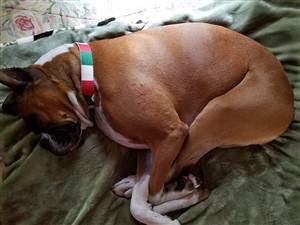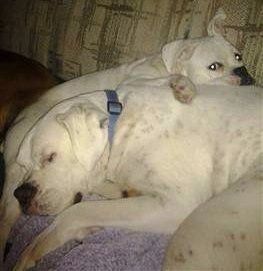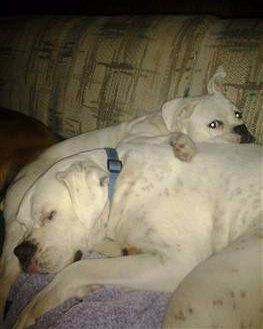Boxer Dog Gas & Flatulence
Overview
The medical term for gas is flatulence and this sort of problem is not uncommon with the Boxer breed.
While some may joke about a dog farting (not the medical term) a lot, excessive flatulence points to a disturbance within the digestive tract that should be addressed
In some cases, high levels of gas can point to rare health issues.
And when all is said and done, if there are steps you can take to reduce the amount of gas that a Boxer dog has, everyone in the household will thank you.
So, in this section, we’ll discuss:
- What gas technically is
- How much is normal
- Possible, yet rare, health conditions that have flatulence as a symptom
- What causes flatulence in canines
- Steps you can take to decrease the amount of gas that a Boxer dog passes
Bella Fiora, at 5 years old
Photo courtesy of Eileen Kelley
What, Exactly, is Gas?
There is always some amount of gases in the digestive tract. Fiber, starch and complex sugars are not easily digested.
These food elements are fermented by bacteria in the colon, which produces a combination of gasses known as flatus.
Flatus is comprised of several vapors that are completely odorless, which includes nitrogen (about 59%), hydrogen (about 21%), carbon dioxide (about 9%), methane (about 7%) and oxygen (about 4%).
Then, there one type of gas that does have a bad odor: hydrogen sulfide (about 1%); while this is the gas found in the smallest quantity, it has such a noxious smell that when it is released along with the other vapors, the odor can be quite overpowering.
It’s important to note that just about all animals (mammals including humans and dogs, even insects) pass gas.
How Much Gas is Normal for a Boxer Dog?
You may be well aware of the problem with cattle releasing methane as a contributing factor of greenhouse gas emissions. Yet, termites actually pass gas more than any other animal and release more methane than cows do.
Of the top ten animals that naturally have flatulence
(termites are #1, cows are #5), dogs come in at #7, with slightly more gas than humans at #9.
It is normal for a Boxer dog to pass gas anywhere from 5 to 10 times per day. Some will be silence farts and others you will smell from clear across the house. If a Boxer is passing gas much more frequently than this or if the gas is particularly noxious, it will be time to evaluate what is causing the excessive gas and make some changes.
Health Conditions that Can Cause Excess Gas
While rare, some cases of gas can be caused by a health condition:
- Malfunction of the pancreas. In these cases, there are usually problems with food absorption. Symptoms include fever, vomiting, diarrhea, loss of appetite, dehydration, flatulence, fatigue and/or signs of abdominal pain.
- Respiratory disease. Respiratory disease causes an increased respiratory rate that can lead to a dog gulping his food faster than normal, which leads to gas. Signs include the coughing and labored breathing.
- Inflammatory bowel disease. With this, there is a bacterial overgrowth in the small intestines. Symptoms may be chronic or may come and go. This includes diarrhea, vomiting and resulting weight loss. The dog may have more bowel movements than normal yet with less stool produced. Feces may also contain blood.
- Neoplasia. This is an abnormal growth of tissue. If this occurs in the bowel, it can cause excessive gas. The growth (tumors) may be non-cancerous (benign), pre-cancerous (pre-malignant) or cancerous (malignant).
4 Top Causes of Excessive Gas with Boxer Dogs
This section will go into the details of how to treat gas problems with Boxer dogs that are related to food and other simple causes (non-medical emergencies) that can often be treated at home.
1) Eating Too Fast –
When a dog eats too quickly this can certainly cause excess gas; however, since this can also cause
bloat, a dangerous and sometimes deadly condition, it is important to make changes. Gulping down food too quickly causes gas in 3 ways:
1-
When a dog gulps down food too fast, he also brings a lot of air along with it. This can be released as burps, however a portion of it will travel down with the food and lead to flatulence.
2-
The food is not chewed enough to be easily digested. The longer it stays in the digestive tract to be digested, the higher the chance of it being involved in producing excess gas.
3-
Eating too fast reduces the amount of saliva and its enzymes that would otherwise be mixed into the food to help digest food.
Fortunately, there are some easy fixes for this:
- Only feed your Boxer from slow-feeder bowls. Unlike regular bowls that allow a dog to freely eat his food, slow-feeder bowls will have internal shapes that promote slow ingestion via tunnels, channels or safe barriers that disperse the food bits. This can lead to a dog eating anywhere from 4 to 6 times slower.
- Place a portion pacer in an existing bowl. If you and your Boxer dog like the current bowl that you are using, you can place a stainless steel portion pacer into it. This is ball that works to displace the food, moving around as the dog eats.
- Offer smaller yet more frequent meals. Unlike other breeds that can do fine with one large meal per day (adults) this is not so for the Boxer, that should be fed at least twice. But if your Boxer has excessive gas, you may find it helpful to go from 2 to 3 or even 3 to 4. Overall, he will receive the same amount of food, but spreading it out over the course of the day will help with proper digestion.
- Refrain from feeding your Boxer right after exercise. When a dog is breathing heavier than normal, he will eat faster than normal. This is also important to lower the risk of bloat. A Boxer shouldn’t exercise before or after a meal. Try to keep a 1-hour window.
Marci and Eszmeralda
" Friendly judo practicing"
Photo courtesy of Karoly Tihanyi
Hungary, Pécel
- In multiple-dog homes, having the dogs eat side-by-side can inadvertently create a competitive eating environment in which one or both dogs rush to eat their food. This can be resolved separating the dog’s eating areas, though they do not have to be in different rooms, separate corners of the kitchen usually does the trick
2) Certain Foods
- In some cases of a Boxer's main food being changed, there can be gas problems for the first few weeks as the body becomes accustomed to the new diet. If a Boxer remains gassy or if there have not been any recent changes, the problem may be one particular food ingredient.
Here are the top culprits that can cause a Boxer to suffer from gas:
- Corn - Corn can cause gas problems and the main reason for this is that it is not digestible. Low quality dog foods often contain a lot of corn as this is a filler food.
- Certain meats - Each Boxer is very unique when it comes to gas problems. A meat that causes a problem for one dog may not be an issue for another. For this reason, making a switch from a lamb based meal to a fish based meal or vice-versa can offer relief from a gassy stomach.
- Starches – Starch is the main component in manufactured foods mainly because foods high in starch have a long shelf life, are easy to acquire and are a low-cost ingredient. In reasonable amounts, starch is not bad for canines; it is an energy source; however too much can cause gas. Commercial dog foods contain anywhere from 45 to 75% starch.
- Liver treats – For some dogs, liver treats tend to cause gas problems.

Father and son Boxer dogs
Borisz (left) 6 years old & Marci (right) 2 years old
Photo courtesy of Karoly Tihanyi
- Broccoli - This is a good food choice for dogs when added to meals; it offers vitamins A and C, folic acid, fiber, calcium, magnesium and potassium.
But, it is known for being a gas producing food. This vegetable is a soluble fiber which means that it does not break down until it reaches the dog's large intestines. Once there, it produces gas. Removing this food can help quite a bit.Good alternatives are peas or green beans.
- Table scraps – Giving table scraps to a dog can lead to quite a bit of gas. This is especially true of high fat foods, though any food that is new to a dog can lead to digestive disturbances. In addition, high salt foods can be extremely unhealthy.
- Milk products – There are some milk products that are tolerate by canines, with yogurt and cottage cheese being the two most commonly given without issues. In fact, yogurt can help prevent flatulence. However, others such as whole milk and cheese can turn a dog into a gas-producing machine.
What to do:
In regard to starch/carbs and corn causing gas, when evaluating your Boxer’s main food, figuring out exactly what’s in it can be a bit tricky.
The FDA only requires companies to list out protein, fat, fiber and moisture, so it can be difficult to find out the percentage of carbs that it contains.
We recommend Orijen,
which has an estimated 23% carbs (peas, chickpeas, red and green lentils, navy and pinto beans, alfalfa).
Notably, it contains chicory which is high in inulin; this is a compound that is a great source of fiber and is also a prebiotic which promotes good bacteria in the GI tract, which can greatly aid in proper digestion. (note, probiotics introduce 'good bacteria' and prebiotics nourish the good bacteria that is already there).
The 23% carbs are a low amount that will not only reduce flatulence, but also leaves plenty of room for ingredients that you do want: 36% protein (turkey, chicken, flounder, mackerel, whole eggs) and healthy fats.
The 36% is well above average protein levels when compared to all other commercial foods.
It's a 5-star food across the board and can be found in formulas for puppies, adults, seniors, grain-free and freeze-dried. Their meats, fruits and vegetables are human-grade and it is made in the U.S.
In regard to other ingredients that can cause gas, it’s best to plan exactly what your Boxer is allowed to have and what is off limits. Don’t give in to begging and make sure that everyone in the household is on the same page.
3) Rawhides
–
These are the inner layer of cow or horse hides that have been cleaned and stripped of hair. It’s amazing that these are still on the market.
Rawhides pose many risks.
All rawhides, even those that are made with ‘real beef’, are wound together with a sort of glue that is toxic. Testing has also proved that most contain toxic chemicals includeing lead, arsenic, mercury, chromium salts and formaldehyde. This gives dogs a slow, low-dose poisoning.
There is also risk of salmonella. Yet, among the most pressing concerns is real risk of choking or internal blockage. In addition, these are incredibly hard for a dog to digest and can be a major source digestive upset including gas problems.
There's some great alternatives:
- Knuckle bones - One of the safest bones that you can give to a Boxer, but watch out! Once you start, he'll never want another snack other than his knuckle bone! These are relatively inexpensive and you can obtain them from your local butcher.
- Sweet potato dog chews are a great choice. These can offer a great chewing texture to satisfy a Boxer’s chewing urges while offering ingredients that do not cause gas or possible blockage.
- Yak/Himalayan chews- This is a treat all Boxer owners should know about. These are all natural chews made of 100% yak and cow milk, salt and lime juice. They are a hard chew that lasts a long time, but are all natural and do not pose a choking or digestive blockage hazard as rawhides do. In turn, they do not cause excess gas problems with dogs. When the chew gets small, you can microwave it (20 to 30 seconds), which expands it (just allow it to cool before giving it back to your Boxer dog).
4) An imbalance of bacteria in the digestive system
– The digestive system of canines (like humans) holds both good and ‘bad’ bacteria. Over time, there can be a buildup of ‘bad’ bacteria that causes an imbalance. This imbalance can cause excessive gassy problems as well as constipation, diarrhea, and/or bloating.
How to Fix this:
• Yogurt
- Luckily, what works well for humans also works well for Boxers with bad gas problems due to this sort of bacteria inequity. You'll want to add good bacteria to the digestive system and plain yogurt is a good choice since it contains probiotics.
This is a safe food for dogs to eat - just be sure to NOT obtain the low-fat, low calorie variety as it can contain unsafe additives. Regular, plain white yogurt works very well and most Boxers love the taste. The typical amount for Boxer puppies is 2 to 3 tablespoons per day and 5 tablespoons for adult dogs. Generally, it takes about 1 week to see a reduction in the frequency of flatulence.
• Pineapple - Another food item that works to cut down on gas is pineapple and this is a safe fruit for a Boxer to eat. Do keep in mind that 1 cup has 82 calories and 16 grams of sugar, so it should be given in moderation. With that said, it does work to reduce gas due to the bromelain found in it. Bromelain is a specific enzyme that assists in the breakdown of proteins.
• Prozyme’s enzyme supplement- If your Boxer has really excessive gas and better treats, better food and slower eating does not seem to be fixing the problem (and all health issues
have been ruled out), you may want to speak to your vet about using a safe and healthy supplement to try and resolve this. Our recommended supplement for dogs with gas is Prozyme’s enzyme supplement.
It comes as a powder which makes it very easy to sprinkle on a meal. It is made in the US, does not enter the bloodstream (so it doesn't interact with any medications that a dog may be taking) and it is made from plants.
One of the great things about this supplement for gas is that it may also help with coat issues as well (dulling coats and/or excessive shedding).
Some Additional Notes
Exercise
– For humans, adding moderate exercise after eating can reduce gas as it helps move food along and stimulates the passage of gas through the digestive tract.
Ghost (front; 10 years old) & Liberty (back; 6 years old)
Photo courtesy of Debbie Milstead
This is not recommended for dogs. For breeds that are prone to bloat, exercise right after a meal can trigger this dangerous and sometimes fatal condition. Always allow 1 hour to pass by after a meal before exercising your Boxer dog.
Activated Charcoal - You may have heard that giving a dog activated charcoal can help with gas. However, it is not recommended to give this to a Boxer without express instruction to do so from the veterinarian. This is normally reserved for certain cases of poisoning. If the wrong dose is given, it can cause dangerous dehydration and/or a dangerous surge in blood sodium levels.
Continued Gas Problems
- If you make all of the applicable changes and your Boxer still has issues, it will be time for a vet checkup even if there are no other symptoms. Please remember that diagnosing issues early is the best method for good prognosis and effective treatment.
See Also:
Longest Living Boxer Dogs
- We are documenting this, and always keep this updated to show the 7 oldest Boxers along with Q&A, photos and papers. There is also a slideshow of those who have passed and other teenage Boxers age 13+.





